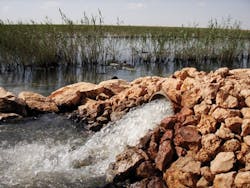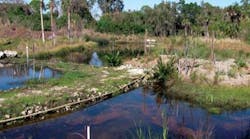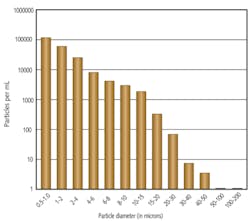Historic Mine Uses Ion Exchange for Copper, Cobalt Removal
PAUL EGER, ADAM SZCZESNIAK, AND MARK KORZENECKI
Soudan State Park contains Minnesota's first iron mine. It began in 1884 as an open pit but switched to an underground operation in 1892. Underground mining continued until the mine closed in 1962. Three years later, the mine and surrounding land were donated to the State of Minnesota and is currently operated by the Department of Natural Resources, Division of Parks and Recreation. Over 15.5 million long tons of high-grade iron ore were removed from the mine during its production lifetime. The mine is about 2,400 feet deep and contains 18 levels. Guides give historic tours of the lowest level of the mine, which also contains two high energy physics laboratories that were constructed in the 1990s and early 2000s.
Water enters the mine through a series of open pits and fractures, with some flow occurring on all levels of the mine. Water flows along small ditches on the side of the mine drifts and is collected in a sump on each level. Pumps are located on three levels to lift the water out of the mine.
The underground iron mine has an average discharge of 60 gpm. Annual average concentrations of dissolved metals present in the mine's discharge included copper (ranging from 83 to 500 μg/l) and cobalt (ranging from 6 to 26 μg/l), both in excess of the current permit standards of 17 μg/l copper and 4 μg/l cobalt. About 94% of the total copper load and 44% of the total cobalt load in the discharge came from a single site near the upper levels of the mine. Treating that one source was projected to significantly reduce downstream water quality concentrations, although the overall discharge was still projected to be somewhat above the permit limits.
Treatment
The DNR installed an ion exchange (IX) treatment system from Siemens Water Technologies in 2004, to treat the major load from the upper levels of the mine. The system included a 5-micron pre-filter followed by a carbon tank and two 3.6 cubic foot IX columns in series. A series of 1-micron pre-filters were later added to improve solids removal. An additional third IX tank allowed the first tank's exchange capacity to be totally used without increasing copper and cobalt in the overall system effluent. Particulate filtration combined with IX vessels using heavy metal selective resins allowed the DNR to achieve up to 99% metal removal efficiencies.
An unexpected change in water quality caused operational problems when the system was first installed, causing treated discharge concentrations to vary and generally exceed permit requirements. In 2006, the Department was fined and signed a stipulation agreement with the Minnesota Pollution Control Agency. The agreement included a requirement to hire a consultant and deadlines for system design and construction. The discharge had to be in compliance with the existing permit by August 1, 2009.
The consultant suggested building a wetland treatment system consisting of a sulfate reducing bioreactor and an aerobic polishing pond to treat the discharge water. When PCA added low level mercury monitoring to the draft permit for the system, high levels of mercury in the mine discharge (40 - 60 ng/l) caused concerns about the potential for the bioreactor to produce methyl mercury. Mercury concentrations were elevated throughout the upper portion of the mine, with some values exceeding 100 ng/l.
The PCA asked the park to develop an alternate treatment process that would reduce copper and cobalt without increasing methyl mercury and maintain the same compliance schedule. Key to the system evaluation was the need to mobilize and treat the discharge quickly. Three systems were considered to treat the entire discharge: chemical treatment with a rotating cylinder, a modular IX system with a commercial resin, and IX using lower cost peat pellets.
The rotating cylinder treatment system is a mobile chemical treatment system that consists of a lime slurry tank, a dosing tank, a pH controller and the rotating cylinder. Initial bench testing indicated that treatment with magnesium hydroxide could reduce copper and cobalt concentrations to permit levels. Additional pilot tests used lime and, at a pH of 9.5, filtered copper and cobalt were reduced to below permit levels. Full-scale testing began on April 15, 2009. This system successfully raised pH and removed filtered metals, but removing solids without a large settling pond proved extremely difficult. The system of settling tanks and bag and cartridge filters generally reduced TSS to around 30 mg/l, but suspended metals exceeded permit levels. Suspended copper was particularly hard to remove, and even after 48 hours of settling, it still exceeded permit levels.
The DNR next installed a modular IX system with a commercial cation exchange resin. With a design capacity of 150 gpm, the Siemens system began operating in July 2009. The system, which included a holding tank, pre-filtration with bag filters followed by cartridges, and two 60 cubic foot IX tanks, was successful in meeting permit limits and complying with the terms of the stipulation agreement (Figure 1).
Work in Progress
Although the IX system has reduced both filtered copper and cobalt to levels below the current respective permit levels of 17 and 4 μg/l, the current permit values are for total metals (approximated by unfiltered values). As IX resins are not designed to remove suspended material, Siemens requires that pre-filtration be included as part of the treatment system to protect the resin.
TSS in the mine water generally range from 5-10 mg/l, but most of the particles are less than 1 micron (Figure 2). The existing 1-micron nominal filtration removes some of the suspended metals, but particles still become trapped inside the resin tanks. This suspended material plugs the IX tanks before the full chemical removal capacity of the resin can be utilized, which increases the estimated treatment cost significantly.
Several tests have been done with higher efficiency (90- 99% efficient) pre-filters in an attempt to remove more of the suspended particles and copper prior to the IX tanks. Although effective in removing 80% or more of the suspended copper, these filters have plugged in less than a day; while the nominal filters (60-70% efficient) have treated the equivalent of one week's flow. The IX tanks cost $10,000 per exchange and, as a result, the DNR must balance filter cost with tank lifetime. In order to reduce premature fouling of the IX resin beds, Siemens currently is providing the DNR with a pilot media filtration system as an alternative particulate removal technology. Tests are ongoing at this time.
Solids removed by the filters are primarily iron oxides and hydroxides and can be safely landfilled so disposal costs are minimal. When the IX resin in the vessels reaches full capacity, Siemens' RCRA-permitted facility in Roseville, Minn., is notified and delivers fresh tanks containing new resin to the site. Exhausted tanks are shipped back to Siemens' treatment facility where the copper and cobalt are removed from the resin and recycled into cement.
Flexibility to Modify
Siemens' wastewater IX system enabled the DNR to meet its discharge limits while eliminating the need for on-site chemicals.
The WWIX system allows the DNR the ease and flexibility to upgrade the number of vessels or modify the media. The treatment system gives the DNR the ability to treat increased springtime flows up to 300 gpm by installing additional banks of WWIX vessels in parallel configurations. The Department has applied for a permit to implement IX as the preferred treatment alternative for the Soudan Mine, but is currently evaluating different filter combinations, including multimedia filtration and pre-treatment with activated carbon or peat pellets for better suspended solids removal.
About the Authors: Paul Eger is principal engineer for the Minnesota Department of Natural Resources, Division of Lands and Minerals in St. Paul, MN. E-mail: [email protected]. Adam Szczesniak is the sales manager for WWIX and remediation at Siemens Water Technologies in South Windsor, CT. E-mail: [email protected]. Mark Korzenecki is a business development manager for WWIX at Siemens Water Technologies in Broadview, IL. E-mail: [email protected].



